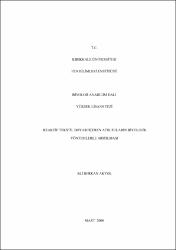| dc.contributor.advisor | Bayramoğlu, Gülay | |
| dc.contributor.advisor | Arıca, M. Yakup | |
| dc.contributor.author | Akyol, Ali Berkan | |
| dc.date.accessioned | 2021-01-16T19:12:35Z | |
| dc.date.available | 2021-01-16T19:12:35Z | |
| dc.date.issued | 2008 | |
| dc.identifier.uri | | |
| dc.identifier.uri | https://hdl.handle.net/20.500.12587/16937 | |
| dc.description | YÖK Tez ID: 176993 | en_US |
| dc.description.abstract | Mikroorganizmaların toksik bileşiklerin atık-sulardan biyolojik arıtımı için kullanılması mevcut metodlara alternatif bir yöntem olarak düşük maliyette kolaylıkla üretilmeleri nedeni ile üzerinde durulmaya ve araştırılmaya başlanmıştır. Beyaz çürükçül fungus ?Lentinus concinnus? biyokütlesi ile sulu çözeltiden azo boyar maddesi (Reaktif Yellow 86) uzaklaştırılması işleminin boya giderim mekanizması ve kapasitesi, adsorbent dozu, pH, sıcaklık ve iyonik şiddet gibi farklı adsorpsiyon parametreleri altında araştırıldı. Ayrıca, immobilize Lentinus concinnus fungal biyokütlesinin (kalsiyum aljinat içinde) sulu çözeltiden Reaktif Yellow 86 boya giderimi Ca-aljinat kürelerinin kontrol amacı ile kullanıldığı sistemde kullanımı araştırıldı. İmmobilize fungal biyokütlenin Ca-aljinat küreleri içerisinde düzgün bir dağılımda büyümelerini sağlamak amacı ile 25°C de 3 gün süre ile inkübe edildi. Biyosorpsiyon denge süresine kesikli sistemde yaklaşık 10 saatte ulaşıldı ve araştırılan fungal biyokütlelerin her ikisi ile de maksimum boya giderimi pH 2.0 da gözlendi. Biyosorbentlerin boya giderim kapasitesi (200 mg/mL boya başlangıç konsantrasyonunda) serbest ve immobilize fungal biyokütle örnekleri için 190.16 ve 134.31 mg/g olarak bulundu. Langmuir ve Freundlich adsorpsiyon izoterm modelleri kullanılarak biyosorpsiyonun matematiksel modellemesi yapıldı. Freundlich izoterm modelinin her iki fungal biyokütle örneklerinin Reaktif Yellow 86 biyosorpsiyonunu tanımladığı belirlendi.Anahtar Kelimeler: Biyolojik giderim; Lentinus concinnus; Reaktif Yellow 86; Ca-aljinat; İmmobilizasyon; Biyoteknoloji | en_US |
| dc.description.abstract | The use of microorganisms for bioremediation of toxic compounds from waste-water streams has emerged as an alternative to the existing methods as a result of the search for low coast, innovative methods. The capacities and bioremediation mechanisms of native white rot fungus ?Lentinus concinnus? biomass preparation in removing of azo dye (i.e., Reactive Yellow 86) from aqueous solution was investigated with different parameters, such as adsorbent dosage, pH, temperature and ionic strength. And also the potential use of the immobilized fungal biomass (in Ca-alginate) of Lentinus concinnus to bioremediation of Reactive Yellow 86 from aqueous solutions was evaluated using Ca-alginate bead as a control system. Ca-alginate beads containing immobilized fungal biomass were incubated for the uniform growth at 25 ºC for 3 days. In the batch system, the biosorption equilibrium time was about 10 h and the maximum dye uptake on all the tested fungal biomass preparations was observed at pH 2.0. The dye uptake capacities of the biosorbents (at 200 mg/L dye concentration) were found to be 190.16 and 164.31 mg/g for free and immobilized fungal biomass preparations, respectively. The Langmuir and Freundlih adsorption models were used for the mathematical description of the biosorption equilibrium. The Freundlich isotherm models were able to describe the biosorption equilibrium of Reactive Yellow 86 on the both of the fungal biomass preparations.Key Words: Bioremediation; Lentinus concinnus; Reactive Yellow 86;Ca-alginate; Immobilized; BiotechnologyKey Words: Bioremediation; Lentinus concinnus; Reactive Yellow 86; Ca-alginate; Immobilized; Biotechnology | en_US |
| dc.language.iso | tur | en_US |
| dc.publisher | Kırıkkale Üniversitesi | en_US |
| dc.rights | info:eu-repo/semantics/openAccess | en_US |
| dc.subject | Biyokimya | en_US |
| dc.subject | Biochemistry | en_US |
| dc.title | Reaktif tekstil boyası içeren atık suların biyolojik yöntemlerle arıtılması | en_US |
| dc.title.alternative | Removal of reactive textile dyes from waste water via biological methods | en_US |
| dc.type | masterThesis | en_US |
| dc.contributor.department | KKÜ, Fen Bilimleri Enstitüsü, Biyoloji Anabilim Dalı | en_US |
| dc.identifier.startpage | 1 | en_US |
| dc.identifier.endpage | 65 | en_US |
| dc.relation.publicationcategory | Tez | en_US |
















